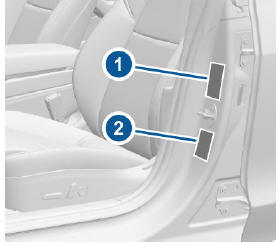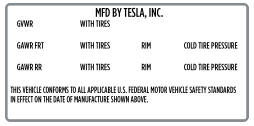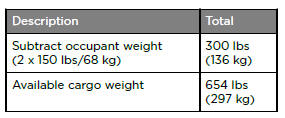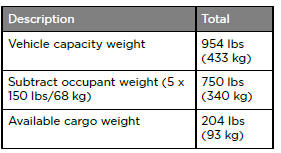Tesla Model 3: Vehicle Loading
It is important to understand how much
weight your Model 3 can safely carry. This
weight is called the vehicle capacity weight
and includes the weight of all occupants,
cargo and any additional equipment added to
your Model 3 since it was manufactured.
Two labels attached to Model 3 indicate how
much weight Model 3 can safely carry.
Both labels are visible on the door pillar when
the front door is open. Note: If your Model 3 is fitted with Tesla
accessory wheels or tires, your Model 3 may
include an additional label indicating that load
capacity may differ from what is stated on the
label. If this is the case, instead of referring to
the label, refer to the Owner's Manual.
Warning: Overloading Model 3 has an
adverse effect on braking and handling,
which can compromise your safety or
cause damage. Caution: Never load more than 55 lbs
(25 kg) in the front trunk. Doing so can
cause damage. Caution: Never load more than 130 lbs
(60 kg) on the rear load floor (above the
lower trunk compartment) or more than
285 lbs (130 kg) in the lower trunk
compartment. Doing so can cause
damage. Caution: Never store large amounts of
liquid in Model 3. A significant spill can cause electrical components to
malfunction. Tire and Loading Information Label The Tire and Loading Information label
provides:
Never change this label, even if you use
different tires in the future. Note: If Model 3 is loaded to its full capacity,
double check all tires to ensure they are
inflated to their recommended pressure levels. The Vehicle Certification label provides:
This is calculated as the weight of Model
3, all passengers, fluids, and cargo.
The GAWR is the maximum distributed
weight that each axle can support. United States: Canada: Caution: To prevent damage, never load
Model 3 so that it is heavier than GVWR
or exceeds the individual GAWR weights. Calculating Load Limits Warning: Trunks are the preferred places
to carry objects. In a collision, or during
hard braking and sharp turns, loose items
in the cabin could injure occupants. Example Load Limit Calculations How much cargo Model 3 can carry depends
on the number and weight of passengers. The
following calculated load limit examples
assume passengers weigh 150 lbs (68 kg). If
passengers weigh more or less, available
cargo weight decreases or increases
respectively. Driver and one passenger
Driver and four passengers
The cargo weight should be distributed
between the front and rear trunks. Caution: Do not exceed the maximum
front trunk load weight of 55 lbs (25 kg). Caution: Never load more than 130 lbs
(60 kg) on the rear load floor (above the
lower trunk compartment) or more than
285 lbs (130 kg) in the lower trunk
compartment. Doing so can cause
damage. Towing a Trailer Warning: Do not use Model 3 for towing
purposes. Model 3 does not currently
support towing. Towing can cause
damage and increase the risk of a
collision. Caution: Using Model 3 for towing before
Tesla-approved towing components and
accessories are available may void the
warranty. Roof Racks Model 3 supports the use of Tesla-approved
roof racks using a Tesla mounting accessory.
To install roof racks, you must use this
accessory and you must use only roof rack
systems that have been approved by Tesla. Failure to do so can cause significant
damage.Load Capacity Labeling


Vehicle Certification Label






